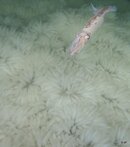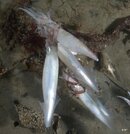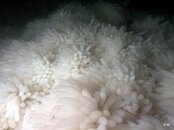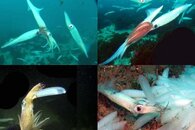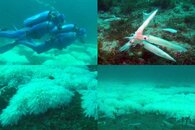DIVE DRY WITH DR. BILL #570: SQUID RUN, PART III: MATING
I've now been a scientist/educator out here on the island for nearly 45 years. My undergraduate training at Harvard taught me that, as a scientist, one has to look objectively at the facts and try not to allow preconceptions to interfere with one's judgment. Back when I was teaching astronomy at the Catalina Island School (Toyon Bay), I presented many "facts" about the solar system and the Universe that today are no longer considered true. As scientists, our understanding of the world about us may (and usually does) change as new observations offer additional information.
When I first arrived on Catalina, I had little knowledge about our local market squid (Doryteuthis opalescens). Being from the Midwest and East Coast, most of what I observed in our waters was new to me. Keep in mind this was about the time my Harvard classmate Vice President Al Gore "invented" the Internet (tee hee), and it had yet to reach the distant shores of Catalina. All I had to rely on were the few field guides to local marine life and my correspondence with experts at my alma mater as well as USC, UCLA, Scripps and Stanford.
Back then our market squid was known as Loligo opalescens, and it was thought to live a mere four to nine months. It was assumed based on observations by divers that all the squid died after mating and egg laying. This was a fair assumption since it is almost impossible to label individual squid with tags and follow them through time given their migratory habits and the billions and billions of them (thank you Carl Sagan) roaming our waters. Although there is still some dispute today, some reputable sources believe squid may live as long as one to two years. They may lay several capsules of eggs in a season, and possibly even survive to mate again the following year.
Since I am not a cephalopod specialist, I can't fully evaluate the conflicting theories about the squid's natural history and mating. I'll stick to what I have observed first hand, and hope that my interpretations are reasonably accurate.
Spawning occurs from about October to April in southern California, although we have witnessed mating swarms over longer periods than that during some years. The squid migrate in to shallower nearshore waters. Males grasp the female and hold her with their many arms (aw, super cuddling). They use a specialized arm known as the hectocotylus to transfer a packet of sperm known as a spermatophore into her mantle cavity. I observed many of the males' arms turning reddish in color as they grasped the female. Apparently this is to warn off other males, although I have observed as many as seven males attempt to mate with a single female. Shades of the 60s!
After insemination, the female's eggs slowly exit the ovaries to a gland which coats them creating a capsule and then expels it through her funnel or siphon. Fertilization occurs via the spermatophore held in her arms. The eggs are laid on soft bottoms (as in the ocean floor, not babies... or babes) in depths of about 30 to 160 ft although some have been pulled up from incredible depths of half a mile. Anywhere from 180 to possibly 500 individual eggs are contained in a capsule which we often refer to as a "candle."
The individual candles have a sticky substance at one end which is used to adhere them to the substrate. Many candles may be laid together in clusters and if these clusters are numerous and extensive they are often referred to as a bed. NOAA states that a single female may produce as many as 20 individual candles during spawning season, limited only by the number of eggs stored in her ovaries.
The capsule is composed of several layers of protein. In between these layers beneficial bacteria grow and they are believed to prevent infection of the eggs by fungi. The capsules sway back and forth in the surge which helps aerate them, providing a continually replenished source of oxygen. The presence of egg clusters apparently triggers other females to lay their candles among them. Hatching depends on water temperature, but is generally in the range of two to three weeks. I'm hoping to be present when this happens so I can film it. The hatchlings are referred to as paralarvae and it is presumed they enter the plankton and eventually mature in midwater and begin forming schools after about two months.
My readers are undoubtedly familiar with the ability of octopus to change colors to match their surroundings. You have been paying attention, haven't you? Market squid also are capable of rapid color changes using pigment structures known as chromatophores that expand and contract. This may assist in camouflage, but may also be a result of "mood" swings. I hate using anthropomorphic terms like that with non-human life forms, but... it may fit in this case. Squid often appear a bluish-white or mottled gold and brown but may rapidly become a dark red or brown. I couldn't quite tell from their coloration what "mood" the ladies were in as they were pursued by the adoring males. Heck, I can't even tell the mood of females of my own species!
Image caption #1: Pair of mating squid with voyeur watching and red tentacles of the mating male; female holding developing egg capsule and inserting one into an egg cluster.

Image caption #2: Jean-Michel Cousteau and Holly Lohuis explore squid egg beds, and a mating "threesome;" large clusters of squid eggs and squid egg bed.

I've now been a scientist/educator out here on the island for nearly 45 years. My undergraduate training at Harvard taught me that, as a scientist, one has to look objectively at the facts and try not to allow preconceptions to interfere with one's judgment. Back when I was teaching astronomy at the Catalina Island School (Toyon Bay), I presented many "facts" about the solar system and the Universe that today are no longer considered true. As scientists, our understanding of the world about us may (and usually does) change as new observations offer additional information.
When I first arrived on Catalina, I had little knowledge about our local market squid (Doryteuthis opalescens). Being from the Midwest and East Coast, most of what I observed in our waters was new to me. Keep in mind this was about the time my Harvard classmate Vice President Al Gore "invented" the Internet (tee hee), and it had yet to reach the distant shores of Catalina. All I had to rely on were the few field guides to local marine life and my correspondence with experts at my alma mater as well as USC, UCLA, Scripps and Stanford.
Back then our market squid was known as Loligo opalescens, and it was thought to live a mere four to nine months. It was assumed based on observations by divers that all the squid died after mating and egg laying. This was a fair assumption since it is almost impossible to label individual squid with tags and follow them through time given their migratory habits and the billions and billions of them (thank you Carl Sagan) roaming our waters. Although there is still some dispute today, some reputable sources believe squid may live as long as one to two years. They may lay several capsules of eggs in a season, and possibly even survive to mate again the following year.
Since I am not a cephalopod specialist, I can't fully evaluate the conflicting theories about the squid's natural history and mating. I'll stick to what I have observed first hand, and hope that my interpretations are reasonably accurate.
Spawning occurs from about October to April in southern California, although we have witnessed mating swarms over longer periods than that during some years. The squid migrate in to shallower nearshore waters. Males grasp the female and hold her with their many arms (aw, super cuddling). They use a specialized arm known as the hectocotylus to transfer a packet of sperm known as a spermatophore into her mantle cavity. I observed many of the males' arms turning reddish in color as they grasped the female. Apparently this is to warn off other males, although I have observed as many as seven males attempt to mate with a single female. Shades of the 60s!
After insemination, the female's eggs slowly exit the ovaries to a gland which coats them creating a capsule and then expels it through her funnel or siphon. Fertilization occurs via the spermatophore held in her arms. The eggs are laid on soft bottoms (as in the ocean floor, not babies... or babes) in depths of about 30 to 160 ft although some have been pulled up from incredible depths of half a mile. Anywhere from 180 to possibly 500 individual eggs are contained in a capsule which we often refer to as a "candle."
The individual candles have a sticky substance at one end which is used to adhere them to the substrate. Many candles may be laid together in clusters and if these clusters are numerous and extensive they are often referred to as a bed. NOAA states that a single female may produce as many as 20 individual candles during spawning season, limited only by the number of eggs stored in her ovaries.
The capsule is composed of several layers of protein. In between these layers beneficial bacteria grow and they are believed to prevent infection of the eggs by fungi. The capsules sway back and forth in the surge which helps aerate them, providing a continually replenished source of oxygen. The presence of egg clusters apparently triggers other females to lay their candles among them. Hatching depends on water temperature, but is generally in the range of two to three weeks. I'm hoping to be present when this happens so I can film it. The hatchlings are referred to as paralarvae and it is presumed they enter the plankton and eventually mature in midwater and begin forming schools after about two months.
My readers are undoubtedly familiar with the ability of octopus to change colors to match their surroundings. You have been paying attention, haven't you? Market squid also are capable of rapid color changes using pigment structures known as chromatophores that expand and contract. This may assist in camouflage, but may also be a result of "mood" swings. I hate using anthropomorphic terms like that with non-human life forms, but... it may fit in this case. Squid often appear a bluish-white or mottled gold and brown but may rapidly become a dark red or brown. I couldn't quite tell from their coloration what "mood" the ladies were in as they were pursued by the adoring males. Heck, I can't even tell the mood of females of my own species!
Image caption #1: Pair of mating squid with voyeur watching and red tentacles of the mating male; female holding developing egg capsule and inserting one into an egg cluster.
Image caption #2: Jean-Michel Cousteau and Holly Lohuis explore squid egg beds, and a mating "threesome;" large clusters of squid eggs and squid egg bed.




